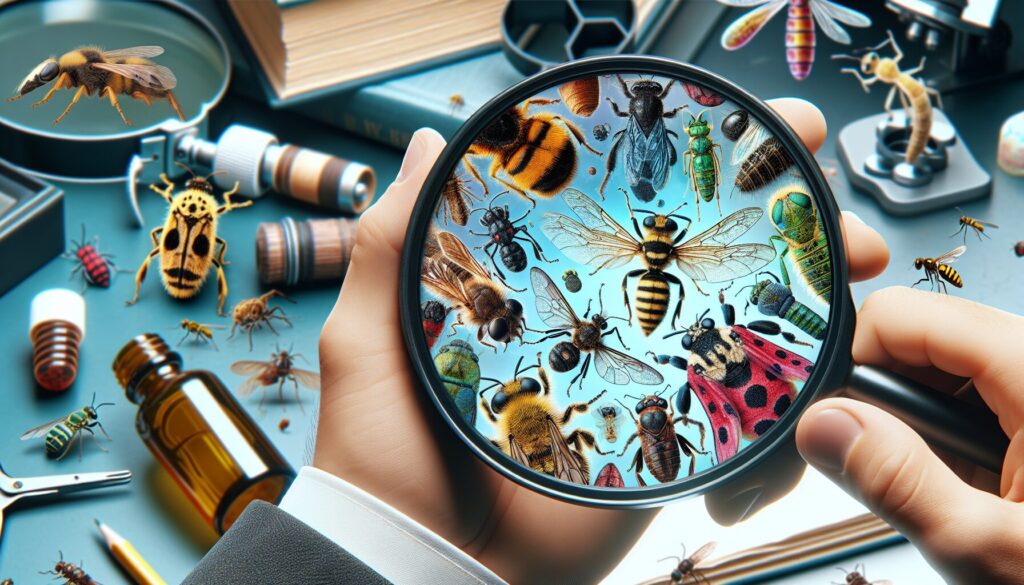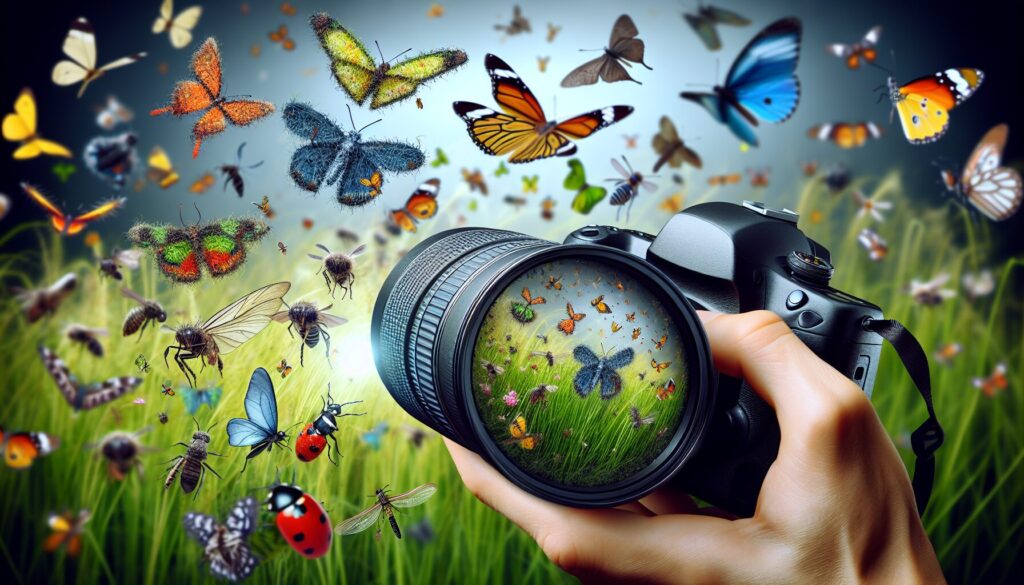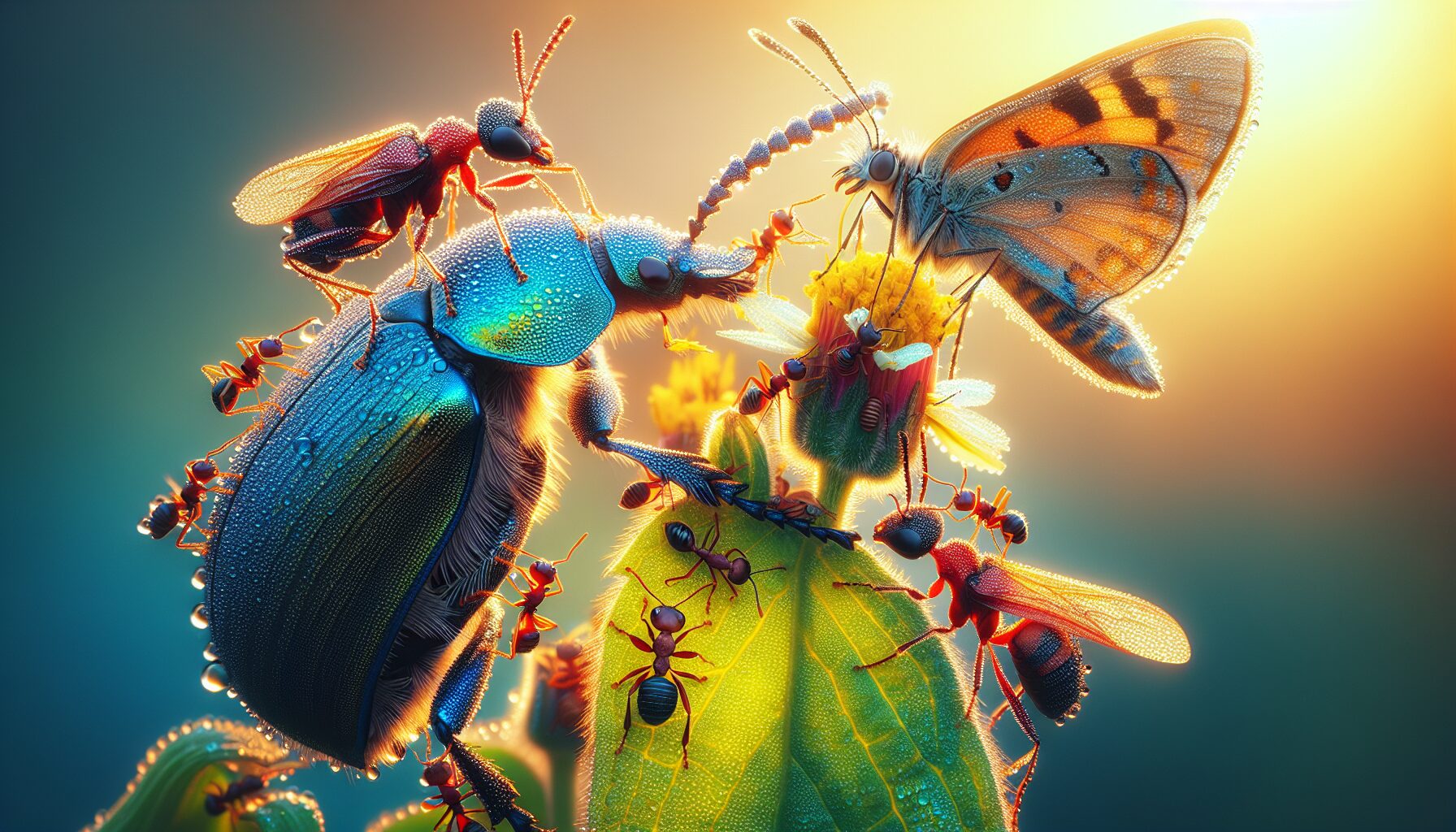Have you ever peered into the tiny world of insects through a macro lens? It’s like opening a door to a miniature universe, rich with colors and textures you’d never notice with the naked eye. I remember the first time I tried it with my Canon EOS R5 using a 100mm f/2.8 macro lens. The detail was incredible! I set the ISO to 200, aperture at f/16, and a shutter speed of 1/60s to capture the vibrant hues of a butterfly’s wings. Macro photography, especially in a biodiversity-rich country like Pakistan, reveals the intricate details of our smallest neighbors. From the shimmering carapace of a beetle to the delicate veins on a dragonfly’s wings, this type of photography uncovers the hidden beauty and complexity of insects. Organizations like `WWF` are keen on promoting this art, highlighting its role in showcasing and preserving biodiversity.
Related: The A-Z of Macro Photography of Insects: Your Complete Reference
The Art and Science of Capturing Insects
Exploring the world of insect photography is like embarking on a thrilling scientific adventure. I remember the first time I captured a stunning ladybug in my garden in Lahore. I used a Canon EOS R5 with a 100mm f/2.8 macro lens. The settings were crucial: ISO 200, f/11, and 1/200s. That combination allowed me to capture the intricate details of the ladybug’s shell and the delicate dew drops on the grass. It’s both an art and a precise science, requiring patience and careful planning.
Moreover, understanding the behavior of insects is essential. They can be unpredictable, and knowing their habits can make capturing them easier. For instance, early morning is an ideal time. The cooler temperatures often make them less active. This is when I got a perfect shot of a dragonfly near the banks of the Indus River, with the morning light casting a magical glow. The use of a tripod helped stabilize my camera for a sharper image. I also recommend a polarizing filter to reduce glare and enhance colors.
Techniques to Enhance Your Shots
Using focus stacking can significantly improve your images. This technique involves taking several shots at different focus distances and combining them. This method creates an image with an incredible depth of field. It’s particularly useful when photographing insects with complex textures and patterns. I experimented with this technique on a honeybee at the National Agricultural Research Centre in Islamabad, capturing every tiny hair on its body.
Additionally, lighting is a key factor. Natural light is often the best choice, yet sometimes a ring flash can provide the necessary illumination without disturbing your subject. I found this particularly helpful when photographing a rare beetle species in the Margalla Hills. It allowed me to highlight the beetle’s vibrant colors without casting harsh shadows. Techniques like these not only enhance the beauty of these tiny creatures but also contribute to our understanding of biodiversity.
How Macro Photography Benefits Biodiversity Studies

Macro photography of insects is like opening a hidden world that’s right under our noses! Imagine using a Canon EOS R5 with a glorious 100mm f/2.8L Macro IS USM lens, and you’re diving straight into the intricate details of an ant carrying a leaf. This technique does more than just create stunning images; it provides crucial insights for biodiversity studies. By capturing these tiny creatures up close, researchers can identify species, track their behaviors, and even monitor their health. This is super important in a country like Pakistan, where diverse ecosystems range from coastal mangroves to the majestic Himalayas.
When I first started exploring macro photography, I was amazed at how the right settings could reveal so much. Shooting at ISO 100, f/16, and 1/30s, I was able to highlight the delicate wings of a butterfly. These images can be used by researchers to observe wing patterns and detect environmental changes. Additionally, these photos aid in identifying new species. The Pakistan Museum of Natural History often relies on such detailed images to catalog and study insects that are yet to be documented.
Supporting Biodiversity Conservation
Furthermore, macro photography helps in conservation efforts by raising awareness. Stunning images of insects can captivate the public, leading to increased interest and funding for biodiversity projects. Organizations like International Union for Conservation of Nature use these visuals to make compelling cases for preserving habitats. According to National Geographic, high-quality images can significantly boost engagement and support for conservation initiatives. Therefore, by capturing these tiny marvels, macro photographers play a critical role in biodiversity studies and conservation in Pakistan and beyond.
The Role of Insects in Ecosystems
Insects are like the unsung heroes of our ecosystems, playing roles that are absolutely vital to the balance of nature. They pollinate crops, decompose organic matter, and even control pest populations. When I was using my Canon EOS R5 with a 100mm f/2.8L Macro IS USM lens, I captured a stunning image of a bee. It was busy pollinating a mustard flower in the lush fields of Punjab. The settings I used were ISO 200, f/11, and 1/200s, which allowed me to get that crisp detail of the bee’s wings and the pollen it carried.
However, insects aren’t just about pollination. They also serve as food for many bird and animal species. This is particularly important in places like the Thar Desert, where the ecosystem relies on insects to sustain life. Additionally, insects help in recycling nutrients back into the soil. This process enhances the soil’s fertility, benefiting agriculture significantly. As you might guess, capturing these little creatures through the lens can bring attention to their importance.
Understanding the Ecosystem Balance
Macro photography of insects helps us appreciate the intricate balance of ecosystems. By highlighting their beauty and significance, it fosters a greater understanding and respect for biodiversity. Organizations like the `International Union for Conservation of Nature` work tirelessly to protect these species. Through photography, we can support these efforts and inspire others to do the same.
Moreover, in Pakistan, focusing on ethical practices while photographing insects is crucial. This ensures we don’t harm them or disrupt their habitats. If you’re passionate about this, you might want to check out our article on `ethical macro photography in Pakistan`. It offers insights on how to capture beauty while preserving nature. Therefore, by photographing insects, we contribute to spreading awareness about their crucial roles in our world.
Technological Advances in Macro Photography

Isn’t it amazing how technology has transformed our world? Macro photography has seen some incredible advances, especially in the realm of insect photography. I remember my first attempt with a Canon EOS R5. I paired it with a 100mm f/2.8 macro lens. The clarity was mind-blowing! I set the ISO to 200, aperture to f/16, and shutter speed to 1/60s. The details of the insect’s wings were unlike anything I’d ever captured before.
These days, many photographers in Pakistan are using tools like focus stacking. This technique combines multiple images taken at different focus distances. It results in a single image with greater depth of field. This is a game-changer for capturing the intricate details of insects. Moreover, the use of ring lights has become essential. They provide even lighting, which is crucial when photographing tiny creatures.
Cutting-Edge Gear and Techniques
Let’s not forget about the advancements in lens technology. Companies like Nikon and Canon have developed lenses specifically for macro photography. These lenses offer incredible sharpness and magnification. This allows photographers to capture the tiniest details. Additionally, mirrorless camera systems have made it easier to shoot in low light. Their electronic viewfinders give a real-time preview of exposure and focus, which is invaluable.
Furthermore, software advancements have also played a significant role. Programs like Adobe Lightroom now offer tools for noise reduction and sharpening. This makes post-processing much more effective. Therefore, these technological advances have made macro photography of insects not just accessible, but also incredibly rewarding for enthusiasts and professionals alike.
Challenges and Best Practices in Insect Photography
Capturing the intricate world of insects through macro photography can be quite a challenge, but it’s incredibly rewarding. I remember the first time I tried this with my Canon EOS R5, using a 100mm f/2.8 macro lens. The details I captured were mind-blowing! However, getting those perfect shots requires patience and skill. Lighting is crucial. Natural light is great, but sometimes it’s too harsh or too dim. I often use a ring flash or a diffuser to soften the light, allowing the insect’s details to pop without casting harsh shadows.
Additionally, focusing can be tricky. Insects move quickly, and their tiny size requires precision. I often set my camera to manual focus, as autofocus can struggle with such small subjects. A tripod can be a lifesaver, providing stability and allowing for slower shutter speeds without blur. Speaking of settings, I usually start with ISO 100, f/16, and a 1/200s shutter speed, adjusting as needed. This helps achieve a balance between depth of field and sharpness.
Overcoming Environmental Challenges
In Pakistan, the diversity of insects is both a blessing and a challenge. The variety means there are countless subjects to photograph, but it also means dealing with diverse environments. Whether in the lush forests of Khyber Pakhtunkhwa or the arid landscapes of Balochistan, each setting presents unique obstacles. Humidity, for instance, can fog up your lens, so a microfiber cloth is essential. Moreover, be mindful of your surroundings. While focusing on an insect, it’s easy to lose track of your footing. Safety should always come first.
Lastly, patience is key. Sometimes you’ll wait hours for the perfect shot, only to have your subject fly away. But when you do capture that perfect moment, it’s all worth it. Organizations like the `Pakistan Entomological Society` offer great resources for budding photographers interested in insect photography. It’s a journey of discovery, revealing the hidden beauty of our natural world.
Conclusion
In essence, the intricate art of macro photography offers a unique lens into the mesmerizing world of insects, revealing details often overlooked by the naked eye. With the right equipment and techniques, such as focus stacking and adept use of lighting, photographers can capture stunning images that not only showcase the beauty but also support biodiversity studies. These images play a crucial role in conservation efforts, raising awareness about the vital ecological roles insects play, from pollination to nutrient recycling. Technological advancements have further enhanced this field, making it accessible and rewarding for both enthusiasts and professionals. By adhering to best practices and overcoming environmental challenges, photographers contribute significantly to our understanding of these small yet mighty creatures. So, grab your camera, explore the tiny wonders around you, and inspire change through your lens. Happy shooting!
Continue Exploring
Unlock the mesmerizing world of insect photography with our all-encompassing guide! From capturing the intricate details to mastering the perfect shot, this is your ultimate resource to become a macro photography pro.
Frequently Asked Questions
What are the benefits of macro photography of insects for biodiversity research?
Macro photography of insects provides detailed images that help researchers identify and study various insect species, contributing to a better understanding of biodiversity. These images can reveal intricate details of insect anatomy and behavior that are often missed in traditional field studies.
How does macro photography contribute to the conservation of insect species?
By capturing high-resolution images of insects, macro photography raises awareness of their beauty and ecological importance. This can lead to increased public interest and support for conservation efforts. Furthermore, these images can aid scientists in monitoring insect populations and detecting changes that may indicate environmental threats.
Why is macro photography considered an important tool for studying insect habitats and ecosystems?
Macro photography allows scientists to examine the intricate details of insect habitats and interactions within ecosystems. These images can uncover how insects interact with their environment, pollinate plants, and contribute to the ecological balance, providing essential data for ecological studies and habitat conservation efforts.


Leave a Reply